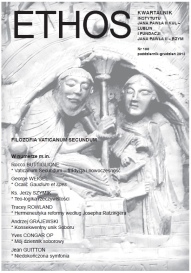Vol. 25 No. 4 (100) (2012): THE PHILOSOPHY OF THE SECOND VATICAN COUNCIL
Full Issue
FROM THE EDITORS
Articles
21-24
published: 2012-12-30
27-51
published: 2012-12-30
52-69
published: 2012-12-30
73-89
published: 2012-12-30
90-100
published: 2012-12-30
101-117
published: 2012-12-30
118-134
published: 2012-12-30
137-150
published: 2012-12-30
151-165
published: 2012-12-30
166-185
published: 2012-12-30
189-204
published: 2012-12-30
205-220
published: 2012-12-30
223-242
published: 2012-12-30
262-284
published: 2012-12-30
329-349
published: 2012-12-30
380-387
published: 2012-12-30
Notes and reviews
357-361
published: 2012-12-30
362-364
published: 2012-12-30
365-372
published: 2012-12-30
373-379
published: 2012-12-30
388-393
published: 2012-12-30
394-400
published: 2012-12-30
Reports
401-411
published: 2012-12-30
412-416
published: 2012-12-30
Through the prism of the Ethos
417-419
published: 2012-12-30
Bibliography of pontifical addresses and documents
421-445
published: 2012-12-30








